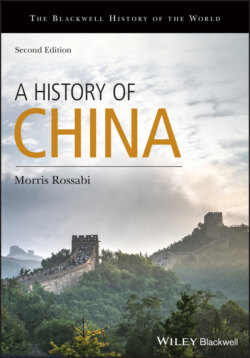A History of China

Реклама. ООО «ЛитРес», ИНН: 7719571260.
Оглавление
Morris Rossabi. A History of China
THE BLACKWELL HISTORY OF THE WORLD
A HISTORY OFCHINA
CONTENTS
Guide
Pages
SERIES EDITOR’S PREFACE
SERIES EDITOR’S ACKNOWLEDGMENTS
PREFACE
FURTHER READING
ACKNOWLEDGMENTS
ACKNOWLEDGEMENTS FOR SECOND EDITION
LIST OF ILLUSTRATIONS
LIST OF MAPS
A NOTE ON ROMANIZATION
[1] EARLY HISTORY, TO 1027 BCE
LAND AND SETTLEMENT
EARLY MANKIND
AGRICULTURAL REVOLUTION IN THE NEOLITHIC ERA
XIA: THE FIRST DYNASTY?
THE SHANG AND THE ORIGINS OF CHINESE CIVILIZATION
ORACLE BONES
RITUAL OBJECTS AS HISTORICAL SOURCES
SHANG SOCIETY
NOTE
FURTHER READING
[2] CLASSICAL CHINA, 1027–256 BCE
“FEUDALISM”?
CHANGES IN SOCIAL STRUCTURE
POLITICAL INSTABILITY IN THE EASTERN ZHOU
TRANSFORMATIONS IN THE ECONOMY
HUNDRED SCHOOLS OF THOUGHT
DAOISM
POPULAR RELIGIONS
CONFUCIANISM
MOHISM
LEGALISM
BOOK OF ODES AND BOOK OF DOCUMENTS
SECULARIZATION OF ARTS
NOTE
FURTHER READING
[3] THE FIRST CHINESE EMPIRES, 221 BCE–220 CE
DEVELOPMENT OF THE QIN STATE
QIN ACHIEVEMENTS
FAILURES OF THE QIN
HAN AND NEW INSTITUTIONS
HAN FOREIGN RELATIONS
EMPEROR WU’S DOMESTIC POLICIES AND THEIR RAMIFICATIONS
WANG MANG: REFORMER OR USURPER?
RESTORATION OF A WEAKER HAN DYNASTY
SPIRITUAL AND PHILOSOPHICAL DEVELOPMENTS IN THE HAN
HAN LITERATURE AND ART
FURTHER READING
[4] CHAOS AND RELIGIOUS AND POLITICAL RESPONSES, 220–581
THREE KINGDOMS
RISE OF SOUTH CHINA
FOREIGNERS AND NORTH CHINA
NORTHERN WEI
SPIRITUAL DEVELOPMENTS, POST-HAN
BUDDHISM ENTERS CHINA
LITERATURE, SCIENCE, AND THE ARTS IN A PERIOD OF DIVISION
NOTE
FURTHER READING
[5] RESTORATION OF EMPIRE UNDER SUI AND TANG, 581–907
SUI: FIRST STEP IN RESTORATION
DISASTROUS FOREIGN CAMPAIGNS
ORIGINS OF THE TANG
TAIZONG: THE GREATEST TANG EMPEROR
TANG EXPANSIONISM
IRREGULAR SUCCESSIONS AND THE EMPRESS WU
TANG COSMOPOLITANISM
ARRIVAL OF FOREIGN RELIGIONS
GLORIOUS TANG ARTS
DECLINE OF THE TANG
TANG FACES REBELLIONS
UYGHUR EMPIRE AND TANG
TANG’S CONTINUING DECLINE
SUPPRESSION OF BUDDHISM
FINAL COLLAPSE
EFFLORESCENCE OF TANG CULTURE
NOTES
FURTHER READING
[6] POST-TANG SOCIETY AND THE GLORIOUS SONG, 907–1279
FIVE DYNASTIES AND TEN KINGDOMS
SONG: A LESSER EMPIRE
A NEW SONG ELITE
NEO-CONFUCIANISM: A NEW PHILOSOPHY
ATTEMPTS AT REFORM
WOMEN AND THE SONG
THE KHITANS AND THE LIAO DYNASTY
EXPANSION OF KHITAN TERRITORY
PRESERVATION OF KHITAN IDENTITY
FALL OF THE LIAO
XIA AND JIN: TWO FOREIGN DYNASTIES
SONG ARTS
SOUTHERN SONG ECONOMIC AND CULTURAL SOPHISTICATION AND POLITICAL INSTABILITY
NOTES
FURTHER READING
[7] MONGOL RULE IN CHINA, 1234–1368
RISE OF CHINGGIS KHAN
LEGACY OF CHINGGIS KHAN
EXPANSION AND EARLY RULE OF EMPIRE
SORGHAGHTANI BEKI, MÖNGKE, AND KHUBILAI
UNIFICATION OF CHINA
KHUBILAI’S POLICIES
MULTIETHNIC AND MULTIRELIGIOUS CHINA
KHUBILAI AND CHINESE CULTURE
DECLINE OF THE YUAN
LEGACY OF THE MONGOLS
NOTE
FURTHER READING
[8] MING: ISOLATIONISM AND INVOLVEMENT IN THE WORLD, 1368–1644
A MORE POWERFUL STATE
OPENING TO THE OUTSIDE WORLD
A COSTLY FAILURE
CONSPICUOUS CONSUMPTION
ARTS IN THE MING
NEO-CONFUCIANISM: SCHOOL OF THE MIND
A FEW UNORTHODOX THINKERS
MING LITERATURE
BUDDHISM: NEW DEVELOPMENTS
SOCIAL DEVELOPMENT AND MATERIAL CULTURE
VIOLENCE IN THE SIXTEENTH CENTURY
FALL OF THE MING DYNASTY
FURTHER READING
[9] EARLY QING: A MANCHU DYNASTY, 1644–1860
PRESERVING MANCHU IDENTITY
KANGXI AND THE HEIGHT OF THE QING
WESTERN ARRIVAL
JESUITS IN CHINA
EXPANSION OF CHINA
QING CULTURAL DEVELOPMENTS
QING FACES ECONOMIC PROBLEMS
STIRRINGS OF DISCONTENT
THE WESTERN CHALLENGE
OPIUM WARS
EXPLANATIONS FOR THE DECLINE OF THE QING
FURTHER READING
[10] LATE QING, 1860–1911
NIAN AND OTHER MINOR REBELLIONS
TAIPING REBELLION
OTHER REBELLIONS
FOREIGN THREATS
DIFFERING COURT RESPONSES TO CHALLENGES
ANTIFOREIGN ACTS AND FOREIGN REACTIONS
LOSSES IN SOUTHWEST CHINA
JAPAN EMERGES
SINO–JAPANESE CONFLICT
SCRAMBLE FOR CONCESSIONS AND US RESPONSE
CHINA HUMILIATED AND THE REFORMERS
BOXER MOVEMENT
COURT REFORMS
FALL OF THE QING
NOTE
FURTHER READING
[11] THE REPUBLICAN PERIOD, 1911–1949
THE 1911 REVOLUTION AND ITS AFTERMATH
WARLORDS IN POWER
THE MAY FOURTH MOVEMENT AND INTELLECTUALS IN THE POST-FIRST WORLD WAR PERIOD
COMMUNIST PARTY
RISE OF CHIANG KAI-SHEK
GUOMINDANG DOMINANCE
COMMUNIST PARTY REVIVAL
LONG MARCH AND AFTERMATH
THE SINO–JAPANESE WAR
THE PACIFIC WAR, THE COMMUNISTS, AND THE GUOMINDANG
CIVIL WAR IN CHINA
FURTHER READING
[12] THE COMMUNIST ERA IN CHINA, 1949 ONWARDS
EARLY PACIFICATION OF BORDER AREAS
EARLY FOREIGN RELATIONS
RECOVERY FROM WARS
CRACKS IN THE COMMUNIST WORLD
GREAT LEAP FORWARD
RETURN TO PRAGMATISM
AN ISOLATED CHINA
GREAT PROLETARIAN CULTURAL REVOLUTION
CHINA REOPENS ITS DOORS
DRAMATIC CHANGES AND MODERNIZATION
TIANANMEN DISTURBANCE OF 1989 AND ITS AFTERMATH
THE PRESENT STATUS OF CHINA
FURTHER READING
INDEX
WILEY END USER LICENSE AGREEMENT
Отрывок из книги
General Editor: R. I. Moore
* Denotes title published.
.....
The diviners sought responses from the ancestors and from Di (who was particularly identified with the Shang royal family), a deity who, along with the river, mountain, and wind gods, controlled the natural world as well as warfare, illness, and other human crises. The king’s interpretation of the cracks foretold the future. On occasion, the bones recorded the actual outcome, which most often confirmed the prognostication. The whole operation – the chiseling of holes, the proper creation of systematic cracks, and the recording of the divination – required enormous effort, time, and expertise, indicating divination’s value to Shang society.
The oracle bones afford glimpses of Shang society. Nearly every aspect of Shang culture, from agriculture to sickness to the interpretation of dreams, was addressed in these records of divination. Since the king himself, reflecting a theocratic system, was the principal diviner, the bones often convey the objectives and aspirations of the elite, as well as their spiritual views. However, Shang religions consisted of more than oracle bones. The bones themselves allude only to rituals, dances, music, and ceremonies, without providing additional details. Thus, they convey only a partial – though invaluable – view of Shang religion and society. Though the bones that have survived constitute less than ten percent of the total actually produced for divination, most specialists believe that they are representative in theme and subject matter of the rest. Some historians believe that the divination inscriptions provide a general picture of the elite’s worldviews; they also recognize that knowledge of Shang China will not, unless new remarkable sources are uncovered, achieve the same level of detail about rulers, the military, and the economy as exists regarding later dynasties.
.....